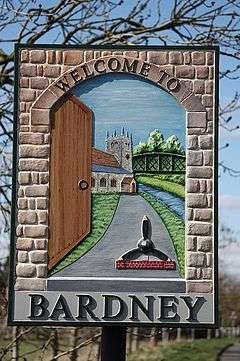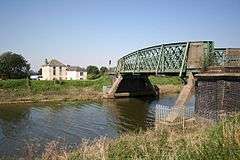Bardney
| Bardney | |
 The village sign |
|
 Nearby bridge over River Witham |
|
 Bardney |
|
| Population | 1,643 [1] |
|---|---|
| OS grid reference | TF120695 |
| – London | 115 mi (185 km) S |
| Civil parish | Bardney |
| District | West Lindsey |
| Shire county | Lincolnshire |
| Region | East Midlands |
| Country | England |
| Sovereign state | United Kingdom |
| Post town | Bardney |
| Postcode district | LN3 |
| Dialling code | 01526 |
| Police | Lincolnshire |
| Fire | Lincolnshire |
| Ambulance | East Midlands |
| EU Parliament | East Midlands |
| UK Parliament | Gainsborough |
|
|
Coordinates: 53°12′39″N 0°19′28″W / 53.210952°N 0.324362°W

Bardney is a village and civil parish in the West Lindsey district of Lincolnshire, England. The population of the civil parish was 1,643 at the 2001 census increasing to 1,848 (including Southrey) at the 2011 census.[2] The village sits on the east bank of the River Witham and 9 miles (14 km) east from the city and county town of Lincoln.
History
The placename comes from the Old English 'Beardan', or "island of a man called Bearda". In 731 Bede renders it as "Beardaneu" and the Domesday Book as "Bardenai".[3]
Once the site of a mediaeval abbey, ruined in Henry VIII's dissolution of the monasteries, agricultural improvement made the village prosperous in the 19th century. Improved transport, first on the River and then the arrival of several railways caused considerable expansion between the traditional centre of the village and the former riverside settlement of Bardney Ferry, where in 1894 the ferry was replaced by the present bridge.[4][5][6][7] A British Sugar factory, built in 1927, survived the closure of the railways but ceased processing on 9 February 2001.[4][8]
Bardney Abbey
Bardney Abbey was founded before 679, perhaps as double house of monks and nuns, and perhaps as a Minster. It was destroyed by the Danes circa 860. Refounded 1087 as a Priory, it became a Benedictine Abbey in 1115, and was dissolved in 1538.[4][9] Bede relates that Bardney Abbey (which he called Beardaneu)[10] was greatly loved by Osthryth, queen of Mercia, and in about 679 she sought to move the bones of her uncle, the very pious St Oswald there.[11] However, when the body was brought to the Abbey the monks refused to accept it, because the Abbey was in the Kingdom of Lindsey, and Oswald, when king of Northumbria, had once conquered them. The relics were locked outside, but during the night a beam of light appeared and shone from his bier reaching up into the heavens. The monks declared that it was a miracle and accepted the body, hanging the King's Purple and Gold banner over the tomb.[10] They are also said to have removed the great doors to the Abbey so that such a mistake could not occur again, so if someone said "do you come from Bardney?", it meant that you had left the door open.[12][13][14]
As well as the wondrous light, other miracles were associated with the remains of King Oswald. The bones at Bardney were washed before interment and ground into which the water was poured supposedly gained great healing powers.[15] In another tale from Bede a boy with the Ague kept vigil by the tomb and was cured.[16] The King's heads and hands had been separately interred, for he had been dismembered in battle.[15] A fragment of the stake on which his head had been impaled was later used to cure a man in Ireland.[17]
In 909, in response to increased viking raids, Oswald's bones were translated to the new St Oswald's Priory, Gloucester.[18]
Lost villages
Near the Abbey is the site of the Deserted Medieval Village of Butyate.[19][20]
There is another abandoned village associated with the former chapels of St Lawrence and St Andrew, north of modern Bardney.[21]
Transport
The river has been used for commercial shipping since time immemorial, but was straightened and improved many times including in 1753 and 1812.[4] A straight course (new cut) was made at Bardney and the lock built in 1770 was re-built in 1865.[22]
In 1870 Bardney was connected to the railway network, and remained so until 1970.[4] The station building survives and is a listed building.[23]
Great Western Festival
In 1972 the area was host to the Great Western Festival, a four-day pop concert (also known as the Bardney Festival). Funded by Lord Harlech and the actor Stanley Baker (amongst others) it attracted 30,000 people to the venue, held at the nearby Tupholme Abbey ruins. Amongst the artistes playing were Roxy Music and Status Quo and, for two nights running, the Rory Gallagher Band. Despite its popularity the show lost money due mainly to bad weather which blighted the event.[24][25][26]
Community
The parish church of St Lawrence is part of the Bardney Group of the Deanery of Horncastle in the Diocese of Lincoln.[27][28] There is also an active Methodist chapel; the current minister is the Rev'd Colin Watkins.[29]
The modern primary school, Bardney Church of England and Methodist Primary School,[30] was opened in 1983.[4] It replaced two earlier schools merged in 1964.[4]
The village has pre-school facilities, including Bardney Mother and Toddler Group which meets at the Methodist Hall, a butcher's shop, a general store and two public houses.
A skate park is planned to be erected by April 2014.
Bardney Gala, held every year on August Bank Holiday Sunday, is a traditional Gala. The event consists of crafts, trade and community stands, funfair rides, bar and BBQ, sports, children's races, car boot sales, classic vehicles, and an Exemption Dog Show.[31]
Administration
Originally part of the Wraggoe Wapentake, and of the Lincoln poor law union in the Parts of Lindsey, the parish is now part of West Lindsey District, and Lincolnshire County Council.
The civil parish has become part of a group that consists of Bardney, Apley and Stainfield parishes. The villages of Southrey and Kingthorpe are also included.[32]
The 2011 electoral arrangements are:
- West Lindsey District Council, Bardney ward councillor: Ian Fleetwood[33]
- Lincolnshire County Council councillor: Ian Fleetwood[34]
- Westminster, Gainsborough constituency Member of Parliament: Edward Leigh[35]
- European Parliament, East Midlands MEPs: Derek Clark,[36] Roger Helmer,[37] Glenis Willmott,[38] Emma McClarkin,[39] Bill Newton Dunn.[40]
Sister city
- (fr)
 – La Bazoge
– La Bazoge
See also
- RAF Bardney
- Tupholme
- Bardney Abbey
- River Witham
- National Cycle Route 1#Norwich to Lincoln
- Louth to Bardney Line
- Lincolnshire Loop Line
- Bardney railway station
- Bardney Limewoods
References
- ↑ Lincolnshire Research Observatory / Office for National Statistics, "Statistics about Bardney, West Lindsey."
- ↑ "Civil parish population 2011". Neighbourhood Statistics. Office for National Statistics. Retrieved 21 April 2016.
- ↑ Mills, A. D. (1991). A Dictionary of English Place-Names. Oxford University Press.
- 1 2 3 4 5 6 7 "Village history with timeline". Retrieved 21 February 2011.
- ↑ "Summary of railway history". Retrieved 21 February 2011.
- ↑ Ludlam, A.J.; Herbert, W.B. (March 1987). Louth to Bardney Branch. Locomotion Papers. Oakwood Press. ISBN 978-0-85361-348-0.
- ↑ Ludlam, A.J. (July 1995). Lincolnshire loop line of the GNR. Locomotion Papers. Oakwood Press. ISBN 978-0-85361-464-7.
- ↑ "History of the sugar factory". Retrieved 22 February 2011.
- ↑ Historic England. "Bardney Abbey (351575)". PastScape. Retrieved 10 April 2010. This gives the foundation date as before 697, but according to Bede St Oswald's bones were moved there in about 679.
- 1 2 Bede. "iii.11". Historia ecclesiastica gentis Anglorum. (as Leo Sherley-Price (trans.) (2008). The Ecclesiastical History of the English People. Penguin Classics. Penguin. p. 160.)
- ↑ Catholic Encyclopedia: St Oswald
- ↑ "Lincolnshire Heritage web page about the legend". Retrieved 12 September 2009.
- ↑ "Parish web site mentioning the legend". Retrieved 22 February 2011.
- ↑ "Local Authority history site, including the legend". Retrieved 12 February 2011.
- 1 2 Bede iii.11
- ↑ Bede iii.12
- ↑ Bede iii.13
- ↑ Heighway, Carolyn (2001). "Gloucester and the new minster of St Oswald". In Higham, N. J.; Hill, D. H. Edward the Elder 899-924. Routledge. p. 108.
- ↑ Historic England. "DMV at Butyate (351591)". PastScape. Retrieved 10 April 2010.
- ↑ Beresford, Maurice; Hurst, John G, eds. (1971). Deserted medieval villages : studies. Woking: Lutterworth Press. p. 193.
- ↑ Historic England. "DMV north of Bardney (892932)". PastScape. Retrieved 10 April 2010.
- ↑ "History of Bardney Lock".
- ↑ Historic England. "the Railway station (506745)". PastScape. Retrieved 10 April 2010.
- ↑ Neville, Richard "Stanley Baker's Barbed Wire Circus", International Times Archive pp. 26–27, 19 June 1972; retrieved 24 June 2001
- ↑ Neville, Richard "Stanley Baker's Barbed Wire Circus", International Times Archive pp. 28–29, 19 June 1972; retrieved 24 June 2001
- ↑ Neville, Richard "Stanley Baker's Barbed Wire Circus", International Times Archive pp. 30–31, 19 June 1972; retrieved 24 June 2001
- ↑ "Ecclesiastical parish details".
- ↑ "Church details".
- ↑ "Methodist chapel web site".
- ↑ "School web site". Retrieved 18 April 2013.
- ↑ "Gala web site". Retrieved 18 April 2013.
- ↑ "Civil parish group web site". Retrieved 2 February 2011.
- ↑ Ian Fleetwood, west-lindsey.gov.uk
- ↑ Bardney and Cherry Willingham ward councillor: Ian Fleetwood, lincolnshire.gov.uk
- ↑ Edward Leigh MP, parliament.uk
- ↑ Derek Clark MEP, europarl.europa.eu
- ↑ Roger Helmer MEP, europarl.europa.eu
- ↑ Glenis Willmott MEP, europarl.europa.eu
- ↑ Emma McClarkin MEP, europarl.europa.eu
- ↑ Bill Newton Dunn MEP, europarl.europa.eu
External links
![]() Media related to Bardney at Wikimedia Commons
Media related to Bardney at Wikimedia Commons
- grid reference TF120695
- Location map for Bardney and the Abbey
- National cycle route 1
- Environment agency flood planning
- Bardney, Genuki.org.UK
- Heritage centre contact details
- Private web site of Lincolnshire railway photos, including several involving Bardney
- National nature reserve: Bardney Limewoods
- Bardney in the Domesday Book